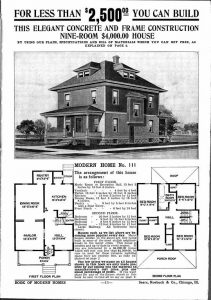From the Queen Anne to the Craftsman, we’re going to cover a wide range of homes in this fifth installment of the History of the American Home! This episode will include American homes from the Gilded Age (1870s) all the way up through the end of World War I. In short, we’re going from “old world” to “new world” in a very short amount of time! Without further ado, let’s get to it!
Queen Anne
 In England during the 1870’s, Richard N. Shaw developed a blend of classical and medieval architecture that was both ornate and excessive. Enter the Queen Anne style. The Queen Anne made it’s American debut in 1876 in Philadelphia during the Centennial Expo.
In England during the 1870’s, Richard N. Shaw developed a blend of classical and medieval architecture that was both ornate and excessive. Enter the Queen Anne style. The Queen Anne made it’s American debut in 1876 in Philadelphia during the Centennial Expo.
This was a time of growth in the post-Civil War era in America. Mass production and factories were becoming more and more commonplace country-wide. New construction methods were being introduced as well with the invention of the scroll saw and band saw. This led to ornamental wood decorations. Window glass was being manufactured, central heat was developed, and balloon framing was in wide use.
Queen Anne homes were the largest and most elaborate homes of their time but were affordable for all economic classes. How is this possible? They were adaptable for size, design, and detail. This meant that a home could be customized to fit a buyer’s budget.
The Queen Anne is iconic for its “never too much” approach to decoration. Exterior siding formed patterns, scrolled woodwork adorned every nook and cranny, asymmetrical facades, and towers were very popular.
Arts and Crafts
Also known as the Western Stick Style, Craftsman, and Craft Movement, the Arts and Crafts style of home ushered in an emphasis on quality, not quantity. The value of individual craftsmanship was put on a pedestal. This was a direct response to the movement towards mass produced home construction which was seen as stale and lacking in quality.
Charles and Henry Greene created this new style in America with a blend of Japanese influence, pitched gable roofs, exposed rafters, and open porches. Thus the “ultimate bungalow” was born! We know them as the Craftsman today. This kind of home is found in every metropolitan area in the country but are especially prevalent in Southern Minneapolis.
American Foursquare
During the increased immigration to the United States in the late 1800’s, more affordable housing was needed. President Teddy Roosevelt put out a call for inexpensive housing while in office in the early 1900’s. The American Foursquare was the answer!
Cubic efficiency at it’s finest, it is also called the American Box, Basic Box, and Prairie Box. It was a basic floor plan with many different exteriors. The Foursquare was also considered a hybrid style with it’s hipped roof, overhangs, horizontal designs, and interior craftsman woodwork. Typically two to two and a half stories high and in the shape of a cube, the symmetrical front had an offset door. The floor plan was generally quartered.
Home kits could be ordered from Sears and Roebuck by mail and sent to their final destination for building. For anyone who has played Red Dead Redemption 2, look for the mail order house kit in the general store catalogs! This video clip shows it at 1:55!
Tudor Style
 The Tudor style home began in England (yes, AGAIN) in the post-Gothic era. It immigrated over to America in the late 1800’s and was adaptable to large and small homes alike. The Tudor sported side-gabled roof lines that were very complex and were adorned with large, decorative chimneys. No porches were built with Tudor homes. There was a flair of Garrison-style influence outside and craftsman influence inside.
The Tudor style home began in England (yes, AGAIN) in the post-Gothic era. It immigrated over to America in the late 1800’s and was adaptable to large and small homes alike. The Tudor sported side-gabled roof lines that were very complex and were adorned with large, decorative chimneys. No porches were built with Tudor homes. There was a flair of Garrison-style influence outside and craftsman influence inside.
After World War II, this style of home fell out of popularity however they can be found all over Minneapolis and St. Paul. 44th Avenue South and also Sheridan Avenue South in Minneapolis are two areas where they are quite prominent.
Prairie Movement
Does the name Frank Lloyd Wright ring a bell? I’m betting it does. We’ve come to the Prairie Movement, the uniquely American break from Greek and Roman styles. This movement was geared  towards reflecting the American Midwest…we’re not just fly-over country, people!
towards reflecting the American Midwest…we’re not just fly-over country, people!
In addition to Frank Lloyd Wright, architects Marion Griffin, Walter Griffin, Myron Hunt, Dwight Perkins, and Robert Spencer made up what was called the Prairie School. Their designs consisted of long, low lines: low pitched roofs (hip), big windows, and little decoration. Built-ins were common in these homes, as were centralized fireplaces.
Today, homes that Frank Lloyd Wright designed in Minnesota can be found all over the state. This list has them all along with their addresses but please be aware that not all buildings on this list are public. Some are privately owned.
Bungalow
The Bungalow hearkens back to when British colonists were settling in the country of India. In the 1890’s and into the early 1900’s the Bungalow became an answer for the demand for cheap  housing in the United States, like the American Foursquare. This style was a blend of several influences in the States ranging from Craftsman, Japanese Teahouse, Spanish Colonial, and Swiss Chalet. The Bungalow was the first home style to be built in quantity by builders.
housing in the United States, like the American Foursquare. This style was a blend of several influences in the States ranging from Craftsman, Japanese Teahouse, Spanish Colonial, and Swiss Chalet. The Bungalow was the first home style to be built in quantity by builders.
Generally smaller in size, Bungalows are very efficient homes. Typically one story or one and a half, the sport low-pitched roofs with exteriors made from local materials. In California, you see stucco or in Chicago it would be brick.
Bungalows are found across America and are in wide use to this day, just check out Zillow!
Art Deco
Our final style of American home that will bring us up to the 1940’s is the Art Deco style. It first premiered in 1925 at the Paris Expo and was in use until 1940.
The classic characteristics of Art Deco are hard-edged geometrics, floral designs, Aztec patterns, Mayan designs, and Native American influences. Art Deco was typically used in multi-family housing, most often in South Beach, Miami.
Art Deco also featured rectangular and curved ornamentation, flat roofs, and porthole windows. Buildings of this style were often constructed using concrete, stucco, stone, steel, aluminum, and glass. The unique porthole windows often featured etched glass. Colors were neon and in abundance! I personally feel it is a very confusing style to look at but to each their own, I guess!
A couple of famous examples of the Art Deco style of architecture would be the Chrysler Building in New York City and Rockafeller Center, also in New York.
The Next Time
Well! We’ve come all the way up to the Second World War so that means the next time we’ll enter into the modern movements. This is going to be a HUGE departure from the ornate wood work we saw up until this time in the American home.
As always if you have any real estate questions, want to buy or sell, know someone who does…just let me know! You can also sign up at my new home valuation website and receive a monthly update on your home’s value at Homebot. It is quick, easy, and will even tell you how much you could charge for an Airbnb!
Happy reading!

